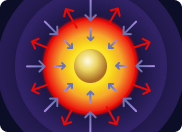For any fusion energy system, achieving a burning plasma is essential for realizing self-sustaining fusion energy. A burning plasma is defined as a state in which the fusion reactions themselves provide most of the heat required to sustain and propagate the fusion process. Inertial fusion energy targets are central to any potential IFE fusion system. These small capsules contain the fuel that will transition into a burning plasma. Their design and physics play a crucial role in squeezing, heating, and igniting the fuel to unleash the immense power of fusion reactions. It is within these targets that the transformative process occurs. Before delving into the scientific challenges related to a burning plasma, let’s review the four stages that IFE targets undergo. For illustration, we will use hot spot ignition as an example.

Heating Phase:
In the heating phase of inertial fusion energy, powerful laser beams or X-rays rapidly heat the surface of a fusion target, usually a small pellet of fuel. This intense energy input creates a plasma envelope around the target, increasing its temperature and preparing it for the subsequent compression phase. The rapid heating is essential for ensuring the fuel can be effectively compressed to the necessary conditions for fusion.

Compression Phase:
During the compression phase, the heated fuel is contained within a carefully designed spherical capsule. The energy from the lasers or X-rays drives an implosion mechanism that subjects the fuel to extreme pressures. This rapid inward force compresses the fuel to very high densities, significantly increasing the likelihood of nuclei collisions, which is critical for initiating fusion reactions.

Ignition Phase:
Ignition is the pivotal moment when the compressed fuel reaches conditions sufficient for nuclear fusion to occur. At this stage, the temperature and pressure overcome the electrostatic forces that repel positively charged nuclei. This allows the strong nuclear force to take over, triggering fusion reactions and marking the transition to a self-sustaining process.

Burn Phase:
In the burn phase, fusion reactions become self-sustaining, continuously releasing significant amounts of energy. Once ignition has been achieved, the energy produced by the fusion reactions maintains the necessary high temperature and pressure conditions, resulting in a sustained energy output.
Science and Technology Challenges & Gaps:
- How can we optimize energy coupling from driver to target to achieve necessary fuel densities and temperatures?
- How can increased laser bandwidth and advanced pulse shaping improve coupling efficiency and mitigate laser-plasma instabilities?
- What are the specific compression and burn requirements for IFE targets to achieve high efficiency and repetition rates?
- How can we address sensitivities to implosion hydrodynamic instabilities, and what are the most effective strategies to reduce mix of ablator/liner into fuel?
- What additional studies are needed to understand the electromagnetic forces between multiple heavy-ion beams and address challenges related to scaling several hundred beams for heavy-ion fusion (HIF) targets?
- What are the optimal methods for reducing burn averaged areal density requirements in magnetically driven inertial fusion?
